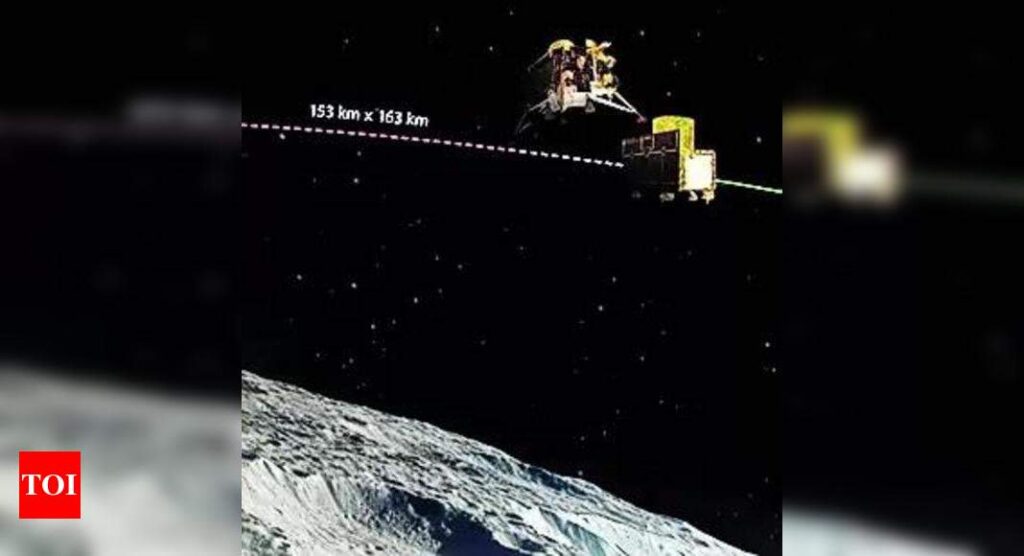[ad_1]
BENGLAURU: The scientific instrument on the Chandrayaan-3 propulsion module, which has been orbiting the Moon for 52 days now, has sent sufficient data in its operations so far, and will continue to work longer.
The instrument, Spectro-polarimetry of HAbitable Planet Earth (SHAPE), will specifically study habitable planet-like features of Earth while it goes around the Moon, and the data from its observations will be used by Isro for studying exoplanets — planets that orbit a star outside the solar system — in the future.
Isro chairman S Somanath told TOI: “SHAPE can only be operated during a certain time when visibility is good from Earth. It is continuously acquiring data when it is operated. The data, however, is a time-invariant, which means that once certain characteristics of Earth are captured they would remain the same and not change with time. We have got enough data so far to meet the payloads objectives, but we will continue to operate it.”
He added, that it would, however, take several months for the analysis of data to be complete and discoveries, if any, to be announced.
Exoplanets have garnered the interest of astrophysicists in the recent part given that they could hold the potential of hosting life. According to NASA: “As on date, more than 5,000 exoplanets have been discovered and are considered “confirmed” out of the billions in our galaxy alone. There are thousands of other “candidate” exoplanet detections that require further observations in order to say for sure whether or not the exoplanet is real.”
The space agency added that remarkably, the first exoplanets were only discovered in the 1990s. “We live in an extraordinary time where in the span of a single generation, the centuries-old question ‘Are there planets orbiting other stars?’ has been answered with a resounding ‘Yes!’,” it adds.
The Chandrayaan-3 propulsion module, was initially meant only to transport the landing module comprising Vikram and Pragyan to Moon and separate from it once an appropriate orbit to do that had been achieved.
Isro, however, added SHAPE to the module in order to take full advantage of it. Describing the objective of SHAPE, Isro says: “Future discoveries of smaller planets in reflected light would allow us to probe into a variety of exoplanets [a planet outside the solar system] which would qualify for habitability, or for presence of life.”
While it was initially expected to have a life of around six months, additional fuel left in it has extended its life by a “few years”. After the propulsion module separated from the landing module, it had more than 150kg fuel left. While some of it would have been used in the last 50-odd days for its operations and to keep it in the 100km orbit, it will still be left with a lot of fuel to continue to orbit the Moon.
The instrument, Spectro-polarimetry of HAbitable Planet Earth (SHAPE), will specifically study habitable planet-like features of Earth while it goes around the Moon, and the data from its observations will be used by Isro for studying exoplanets — planets that orbit a star outside the solar system — in the future.
Isro chairman S Somanath told TOI: “SHAPE can only be operated during a certain time when visibility is good from Earth. It is continuously acquiring data when it is operated. The data, however, is a time-invariant, which means that once certain characteristics of Earth are captured they would remain the same and not change with time. We have got enough data so far to meet the payloads objectives, but we will continue to operate it.”
He added, that it would, however, take several months for the analysis of data to be complete and discoveries, if any, to be announced.
Exoplanets have garnered the interest of astrophysicists in the recent part given that they could hold the potential of hosting life. According to NASA: “As on date, more than 5,000 exoplanets have been discovered and are considered “confirmed” out of the billions in our galaxy alone. There are thousands of other “candidate” exoplanet detections that require further observations in order to say for sure whether or not the exoplanet is real.”
The space agency added that remarkably, the first exoplanets were only discovered in the 1990s. “We live in an extraordinary time where in the span of a single generation, the centuries-old question ‘Are there planets orbiting other stars?’ has been answered with a resounding ‘Yes!’,” it adds.
The Chandrayaan-3 propulsion module, was initially meant only to transport the landing module comprising Vikram and Pragyan to Moon and separate from it once an appropriate orbit to do that had been achieved.
Isro, however, added SHAPE to the module in order to take full advantage of it. Describing the objective of SHAPE, Isro says: “Future discoveries of smaller planets in reflected light would allow us to probe into a variety of exoplanets [a planet outside the solar system] which would qualify for habitability, or for presence of life.”
While it was initially expected to have a life of around six months, additional fuel left in it has extended its life by a “few years”. After the propulsion module separated from the landing module, it had more than 150kg fuel left. While some of it would have been used in the last 50-odd days for its operations and to keep it in the 100km orbit, it will still be left with a lot of fuel to continue to orbit the Moon.
[ad_2]
Source link











More Stories
Congress replaces Kamal Nath, names an OBC as Madhya Pradesh chief | India News
Fire breaks out in ITBP camp in Srinagar; none hurt | India News
Parliament Security: Co-villagers give clean chit to Lalit Jha, parents to move court | India News